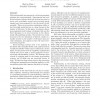Free Online Productivity Tools
i2Speak
i2Symbol
i2OCR
iTex2Img
iWeb2Print
iWeb2Shot
i2Type
iPdf2Split
iPdf2Merge
i2Bopomofo
i2Arabic
i2Style
i2Image
i2PDF
iLatex2Rtf
Sci2ools
SODA
2008
ACM
2008
ACM
Dimension augmentation and combinatorial criteria for efficient error-resistant DNA self-assembly
DNA self-assembly has emerged as a rich and promising primitive for nano-technology. Experimental and analytical evidence indicates that such systems are prone to errors, and accordingly, several error-correction mechanisms have been proposed for the tile model of selfassembly. These error-correction mechanisms suffer either from high resolution loss or a large increase in the number of tile-types. In this paper, we propose dimension augmented proof-reading, a technique that uses the third dimension to do error-correction in two dimensional self-assembling systems. This involves no resolution loss in the two dimensions of interest, results in a smaller increase in the number of tile-types than previous techniques, and appears to have the same errorcorrection properties. Error-correcting systems need to be analyzed in the kinetic Tile Assembly Model; such analysis involves complicated Markov Chains and is cumbersome. In this paper, we also present a set of completely combinatorial crit...
| Added | 30 Oct 2010 |
| Updated | 30 Oct 2010 |
| Type | Conference |
| Year | 2008 |
| Where | SODA |
| Authors | Ho-Lin Chen, Ashish Goel, Chris Luhrs |
Comments (0)

